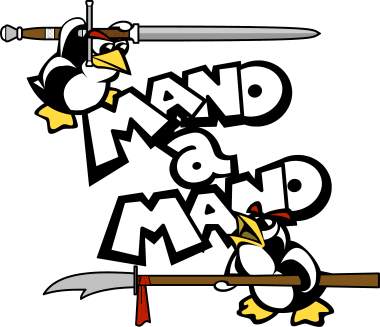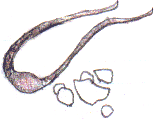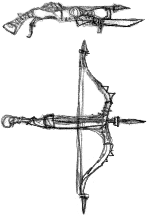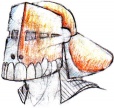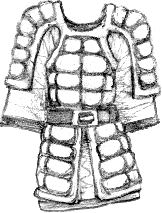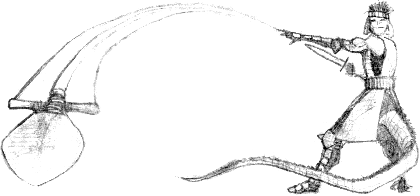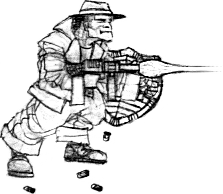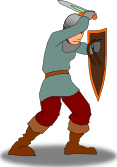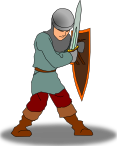Mano a Mano:Complete System
This is the whole system on one page for printing. For chapters and discussion, please use the Table of Contents.
Contents
- 1 Introduction
- 2 Rolling Dice
- 3 Success Rolls
- 4 Character Points (CP)
- 5 Character Points
- 6 Characters
- 7 Equipment
- 8 Equipment
- 9 Action Rules
- 10 Action
Introduction
Mano a Mano is a Role-Playing System - a set of rules for Role-Playing Games (RPGs) - created by Seth Galbraith and Benjamin Galbraith. Mano a Mano is a simple, flexible system which emphasizes realistic hand to hand combat. Mano a Mano can be used for almost any genre of RPG.
http://gameartsguild.com/mano-a-mano
You may create and distribute copies of Mano a Mano in this original form or with your own modifications. Anyone who receives these copies and modifications may do the same. See the Creative Commons Attribution-ShareAlike license for details:
http://creativecommons.org/licenses/by-sa/2.5
Rolling Dice
Success Rolls
Rolls and Modifiers
Some actions are always successful and some are never successful, but many actions have a random chance of success. When rolling for the success of an action, roll a twenty-sided die (d20) and add success modifiers to the result. If the total is greater than the difficulty of the action plus difficulty modifiers, then the action is successful. The action is also automatically successful if the die roll is 20 before adding success modifiers.
If you do not have a d20, you can roll a ten-sided die (d10) and double the result (d10 × 2). If you roll a 1 the doubled result is 2, if you roll a 2 the doubled result is 4, if you roll a 3 the doubled result is 6, and so on. Most d10 are numbered 0 to 9, but the 0 represents 1, so if you roll a 0, the doubled result is 20. The chance of getting 20 this way is twice as likely, so you can ignore the automatic success rule, or make a second d10 roll, but don't double the result. If the second roll is more than 5 then the action is automatically successful.
If you do not have a d10 or a d20 you can use a six-sided, eight-sided or twelve-sided die (d6, d8 or d12). Subtract 1 from the result and then double the value if you use a d12, triple the value if you use a d8, and multiply the result by 4 if you use a d6. (Instead of subtracting 1 it may be simpler to count the highest number on the die as 0.) If the result is 20 or more, you can either ignore the automatic success rule, or make a second roll with the same die. If the second roll is more than 8 on a d12, more than 5 on a d8, or more than 4 on a d6 the action is automatically successful.
| first roll | automatic success (if the first roll is at least 20) |
| d20 | always automatically successful |
| d10 × 2 | roll 6, 7, 8, 9 or 0 (10) on a d10 |
| (d6 - 1) × 4 | roll 5 or 6 on a d6 |
| (d8 - 1) × 3 | roll 6, 7 or 8 on a d8 |
| (d12 - 1) × 2 | roll 9, 10, 11 or 12 on a d12 |
Difficulty
| difficulty | description |
|---|---|
| 5 | Anyone will usually succeed |
| 10 | Experts usually succeed |
| 15 | Difficult even for experts |
| 20 | Nearly impossible without training |
| 25 | Often impossible even for experts |
Difficulty values are often determined by adding 10 to a modifier such as a character's ability level. This can be used to resolve contests between character's using different abilities or the same ability against each other. For example, suppose two characters are having a contest, and both have the same ability level. Adding that level to a die roll for one character and adding that level to a difficulty of 10 for the other character gives both characters a 50% chance of winning the contest.
If a contest can be tied, do two success rolls with each character taking turns adding their modifier to the roll or a difficulty of 10. One character can succeed while the other fails or the result can be tied two ways: both characters can succeed or both characters can fail. If it is not possible for both to succeed, then both characters fail when either type of tie occurs. If it is not possible for both to fail, then both character's succeed when either type of tie occurs.
Circumstance Modifiers
Environment and hastiness can effect the difficulty of an action. Add 2 to the difficulty modifiers for unfavorable circumstances. Add 4 to the difficulty modifiers for hostile conditions. Modifiers for unfavorable circumstances and hostile conditions are not added to other modifiers for unfavorable circumstances or hostile conditions. When more than one of these modifiers apply, use the modifier which increases the difficulty the most. If multiple unfavorable circumstances compound each other, treat the combination as hostile conditions by adding 4 to the difficulty instead of 2.
Add 2 to the success modifiers for favorable circumstances, or add 4 to the success modifiers for very favorable circumstances. Modifiers for favorable or very favorable circumstances are not added to other modifiers for favorable or very favorable circumstances. When more than one of these modifiers apply, use the best one. If a combination of favorable circumstances is much better than the individual circumstances, treat the combination as a single very favorable circumstance by adding 4 to the success modifiers instead of 2.
Character Points (CP)
Character Points
Many things described in the Mano a Mano Role-Playing System - including characters, equipment and templates - have a Character Point (CP) value. CP is a rough estimate of how valuable that thing is. Players often design new PCs with a CP limit of about 300 CP, not including equipment. Minor NPCs usually have about 250 CP. The most powerful PCs and legendary heroes have up to 1000 CP. Powerful superheroes could have as much as 3000 CP. CP might also be used to compare the strength of the characters and equipment on opposing teams.
Template Character Points
(See Game Design/Templates.)
|
|
natural armor
natural weapons
|
Character Character Points
(See Character Development/Character Creation.)
| ability levels | 5 CP |
| more speed | 20 CP |
| less speed | -20 CP |
| agility levels | 10 CP |
| toughness levels | 3 CP |
| strength levels | 5 CP |
| running levels | 10 CP |
| swimming levels | 10 CP |
| airspeed levels | 10 CP |
Equipment Character Points
(See Game Design/Equipment.)
|
|
Characters
Mano a Mano:Characters used to include:
- Mano a Mano:Abilities
- Mano a Mano:Templates
- Mano a Mano:Make a Template
- Mano a Mano:Character Creation
- Mano a Mano:Make a Character
Now you should reference
Equipment
Equipment
Decide what equipment will be included in the game, and who may use it. If the shapes or sizes of the templates are very different, each template might have a separate equipment list. Also decide what equipment characters should have when they start the game. Starting equipment may depend on a character's occupation. A character could start with a certain amount of CP in equipment or money to buy equipment. (See Game Design/Occupations.)
Equipment lists show the features of items in the game, mass, heft, power and CP value, similar to the equipment section of a character sheet, except that the equipment list is independent of the character using the equipment. A detailed equipment list may include details such as the reduced pull required to keep a compound bow drawn, the procedure for operating firearms (cocking, reloading, burst fire, etc.) or the type of damage inflicted by weapons.
Item CP
Some items, especially weapons and armor, have a CP value based on the item's features, mass, heft and power. This value could be used to determine equipment prices or to limit the amount of equipment a character can have.
Mass
This is the item's mass in kilograms. Weapon mass is based on heft (see below.) The mass of medieval armor is typically the wearer's mass multiplied by the armor's cover and absorption divided by 200. Some armor is heavier, especially scale armor and brigandine which are held together by a heavy cloth or leather backing. Modern armor can be lighter. An item's mass also modifies its CP:
| mass | CP | mass | CP | |
|---|---|---|---|---|
| 0.000 kg | 10 | 3-5 kg | -2 | |
| 0.001 kg | 9 | 6-10 kg | -3 | |
| 0.002 kg | 8 | 11-20 kg | -4 | |
| 0.005 kg | 7 | 21-50 kg | -5 | |
| 0.01 kg | 6 | 51-100 kg | -6 | |
| 0.02 kg | 5 | 101-200 kg | -7 | |
| 0.03-0.05 kg | 4 | 201-500 kg | -8 | |
| 0.06-0.10 kg | 3 | 501-1000 kg | -9 | |
| 0.11-0.20 kg | 2 | 1001-2000 kg | -10 | |
| 0.21-0.50 kg | 1 | 2001-5000 kg | -11 | |
| 0.51-1.00 kg | 0 | 5001-10,000 kg | -12 | |
| 1.01-2.00 kg | -1 | 10,001-20,000 kg | -13 |
Heft
Each point of Heft is worth -10 CP. Heft is the power a character's limb must have (including leverage,) to wield the weapon easily. A weapon's heft is usually based on it's mass, but a hand weapon weighted for extra attack power, such as a mace, may have a little more heft. The heft of a bow reflects it's pull rather than it's weight. A firearm with a strong kick may have extra heft to reflect it's kick. If a weapon's heft is greater than the power of the limb holding it, the weapon is unwieldy. Unwieldy weapons may only be used to do one quick action per turn (and no strenuous actions.)
| Heft | Mass | Heft | Mass | |
|---|---|---|---|---|
| 0 | 0 kg | 12 | 7 kg | |
| 1 | 0.01 kg | 14 | 10 kg | |
| 2 | 0.1 kg | 16 | 15 kg | |
| 3 | 0.4 kg | 18 | 20 kg | |
| 4 | 0.7 kg | 20 | 30 kg | |
| 5 | 1 kg | 25 | 50 kg | |
| 6 | 1.5 kg | 30 | 70 kg | |
| 7 | 2 kg | 35 | 100 kg | |
| 8 | 2.5 kg | 40 | 150 kg | |
| 9 | 3 kg | 45 | 200 kg | |
| 10 | 5 kg | 50 | 300 kg |
Power
Each point of power is worth 10 CP. A weapon's power is almost never less than it's heft. A well balanced hand weapon might have more power than it's heft, and a firearm can have much more power than heft.
Features
Some features are numbers and some are not. To show that an item has a feature which is not a number, just list the feature's name. If an item has a feature which is a number, such as range, cover, absorption, shots or turns, list the number followed by the name of the feature.
- range (1 CP per meter)
- Range is a number which is the weapon's maximum effective range in meters. To save space, range can be listed as the number and an "m" (for meters) instead of the word "range". Most natural weapons and hand weapons have no range. Small amounts of reach which make a big difference in combat are reflected by higher template agility and combat abilities or control for some hand weapons (longer swords, staffs and polearms.)
- cover and absorption (5 CP × cover × absorption or 50 CP × absorption)
- Cover and absorption are numbers which describe the effectiveness of armor, helmets and shields. Absorption is the amount of attack power blocked by a piece of armor. Cover increases the difficulty of hitting a part of the body which isn't armored. Items with cover always have absorption and item's with absorption always have cover. The CP value of absorption and cover is 5 multiplied by cover and absorption, or 50 multiplied by absorption if the cover is complete. For example, a piece of equipment with 5 cover and 2 absorption has 50 CP worth of absorption and cover, and a piece of equipment with complete cover and 6 absorption has 300 CP worth of absorption and cover.
- offense (5 or 10 CP)
- Offense is a number (1 or 2) which is added to a character's attack modifier with this weapon. Most flexible weapons have this feature because they are difficult to parry and help grappling attacks by trapping limbs and weapons. 1 offense is worth 5 CP and 2 offense is worth 10 CP.
- control (10 or 20 CP)
- control is a number (1 or 2) which is added to a character's attack and defense with this weapon. Weapons which have extra reach but are still easy to control have this feature. 1 control is worth 10 CP and 2 control is worth 20 CP.
- sharp (20 CP)
- sharp weapons do all damage instead of half damage and half stun. Making a useful cutting or piercing tool is more difficult and makes the item a deadlier weapon, so this feature is worth 20 CP.
- padded (5 CP)
- padded weapons do all stun instead of half damage and half stun. Padding a weapon so that it only does stun damage is difficult and actually increases the weapon's CP value by 5 CP.
- two-handed (-10 CP)
- Two handed weapons are normally used with two hands. It is possible to wield a two-handed weapon in one hand, but then there is some penalty: If the weapon has the control or offense advantage, it loses those advantages. If the weapon does not have control or offense then it's heft is increased by 50% when wielded in one hand, possibly making the weapon unwieldy. This feature is worth -10 CP.
- shots (up to 20 CP)
- Shots describes a weapon's rate of fire. Weapons without the shots feature, such as hand weapons and most thrown weapons, never need reloading. Not having the shots feature is worth 20 CP. This feature has two numbers. The first number is the number of times a character can fire the weapon without reloading (shots before reloading.) The second number is the number of turns required to reload a weapon after all of it's shots have been fired (reload time.) Each shot can represent a single bullet, a burst of bullets or a full turn of continuous automatic fire.
| shots before reloading |
CP value | |
|---|---|---|
| 1 | -2 × the reload time | |
| 2 | 5 - 2 × the reload time | |
| 3 | 10 - 2 × the reload time | |
| 4 | 12 - 2 × the reload time | |
| 5 | 14 - 2 × the reload time | |
| 6 | 16 - 2 × the reload time | |
| 7 | 17 - 2 × the reload time | |
| 8 | 18 - 2 × the reload time | |
| 9 | 19 - 2 × the reload time | |
| 10 or more | 20 - 2 × the reload time |
- flash (-5 CP)
- The weapon makes a bright, but not blinding, flash when fired, like a gun.
- noise (-10 CP)
- The weapon makes a loud, but not deafening, noise when fired, like the report of a gun.
- smoke (-20 CP)
- the weapon makes a lot of smoke when fired, which impairs stealth and future aiming, like a black powder gun.
Equipment List
Polearms
spear/trident (58 CP, 3 kg, 3 heft, 4 power, sharp, two-handed, 2 control)
pike (39 CP, 10 kg, 4 heft, 5 power, sharp, two-handed, 2 m)
other polearm (57 CP, 6 kg, 4 heft, 5 power, sharp, two-handed, 2 control)
Action Rules
Action
Rounds
A round of action represents one to two seconds of game time - enough time for most characters to perform a single action or quick combination. Each character has one turn during each round. Rounds can be measured from the beginning of any character's turn until the beginning of their next turn (or from the end of their turn until the end of the next.) Characters with ¼ speed must skip three out of four turns. After one turn of moving and performing actions, the character cannot move or perform actions on his next three turns. Characters with ½ speed must skip every other turn. Characters may skip more turns than they are required to skip. At the end of a character's turn, the character recovers one stun if they have any.
Stealth and detection abilities are used for surprise attacks. If two characters are mutually stalking each other, do two separate rolls. If both fail, combat doesn't happen. If a character successfully surprises another without being surprised himself, the character with the advantage of surprise gets to go first. If both succeed, they fight without either having the advantage of surprise. If there is no surprise attack, characters may choose to start out either evading (+4 defense modifier until the character's first turn) or ready to counter, and who goes first is decided by the circumstances (whoever throws the first punch in the story,) or random die rolls if there is a dispute. Characters with longer weapon range usually have the opportunity to attack first. Characters typically take turns in the order their players are seated, going around the group of players clockwise. To move in formation, characters may delay their turns until they are sequential.
On his turn, a character can prepare a counterattack, move and do one action, or move and do a combination of actions (combo).
To counterattack the character waits to move and perform actions until someone attempts to attack them. If no one attempts to attack the counterattacking character until their next turn, then they have effectively skipped the turn where they prepared a counterattack and continue with their next turn as normal. The counterattacking character moves and performs their action or combo before the attacker's action or combo, but after any movement the attacker does before acting. This gives the counterattacking character a little more control over positioning. After the counterattack, the attacker can change his action or combo, but cannot reuse any movement he used up before the combo.
Counterattacking delays a single turn, but does not change the order of characters turns. For example, suppose three characters are fighting. The first character prepares a counter attack. The second character, his ally, attacks the third character, their enemy, and misses. The third character decides to attack the first character, but the first character gets to counterattack first. The third character finally gets to attack after the counterattack. Now it is the first character's turn again even though he just counterattacked in the middle of the third character's turn.
In a combo a character can perform one quick action for each point of speed (rounded up, so a character with ¼ or ½ speed can perform one quick action), plus an extra quick action if the combo includes actions with multiple weapons. A character can only do a combo when he is healthy.
Movement
Each point of running, swimming or airspeed allows the character to move one meter per second, 3.6 kilometers per hour, a little over two miles per hour or one space per turn, where a space is about 2 meters wide and a turn is about 2 seconds. Characters can move more than once during their turn (before and after performing actions) but the total distance may not exceed their running, swimming or airspeed.
- Swimming
- Swimming is also added to striking and grappling rolls and defense against striking and grappling while swimming. When characters fight while swimming, striking attacks do half as much stun as they do in air, but no more or less damage.
- Flying
- A character's maximum rate of ascent and safe rate of descent is half of their airspeed. When a flying character ascends 1 meter vertically (under their own flying power) their airspeed is temporarily reduced by 1 until they descend again or land. A character can no longer ascend when their airspeed is 0. When a character descends 1 meter vertically their airspeed is temporarily increased by 1 until they reach twice their normal airspeed, ascend or land.
- Jumping
- Running is also the maximum distance a character can jump with a running start. If the character can barely jump across a gap (within 1 meter of their maximum jumping distance) they must make a success roll using their acrobatics ability or fall into the gap. Without a running start a character can jump half as far. A character can jump vertically half as high as they can jump horizontally (half of their running with a running start, a quarter of their running without it.) If the character can barely make a vertical leap (within 1 meter of their maximum jumping height) they must make a success roll using their acrobatics ability or fail to reach the required height.
- Climbing
- For each climb make a success roll using the character's climbing ability vs. the difficulty of the climb, which depends on the surface, slope and length of the climb. If the character is not successful he looses his grip and falls. If the character is still able to climb after falling he can attempt the climb again. While a character climbs he can move and perform one quick action per turn. How far the character moves each turn depends on the nature of the climb.
| difficulty | surface or structure | movement | |
|---|---|---|---|
| 0 | ladder, steep mountain | ½ running (rounded up) | |
| 5 | rope, pole | 1 meter per turn | |
| 10 | wall or cliff with hand holds | not strategically significant | |
| 15 | finger holds only | not strategically significant | |
| 20 | sheer surface | not strategically significant |
- When the height of the climb is more than one story or 3 meters, a fall may be potentially dangerous, depending on the surface which stops the fall. If the height of the climb is more than two stories or 6 meters, the fall may be potentially lethal, depending on the surface. Falls of 30 meters or more are usually potentially lethal.
- If a fall is potentially dangerous or lethal, make another success roll. This roll has the same difficulty as the climbing roll but the falling character adds his agility to the roll and he can use either his climbing ability or his acrobatics ability. If the fall is potentially dangerous, success means the character is unharmed and failure means the falling character takes damage and stun equal to his toughness. If the fall is potentially lethal, success means the character takes damage and stun equal to his toughness and failure means the character takes damage equal to his stamina. Armor does not protect a character from this damage and stun.
- Encumbrance
- Carrying capacity (CC) is the amount of equipment a character can carry without being encumbered. An encumbered character moves at half of his normal swimming and running speed. An encumbered character cannot perform strenuous actions or fly. A character cannot carry more than twice his CC. CC is determined by the character's strength.
| Strength | CC | Strength | CC | Strength | CC | |||
|---|---|---|---|---|---|---|---|---|
| 0 | 0 kg | 17 | 400 kg | 34 | 12,000 kg | |||
| 1 | 1 kg | 18 | 500 kg | 35 | 15,000 kg | |||
| 2 | 2 kg | 19 | 600 kg | 36 | 20,000 kg | |||
| 3 | 5 kg | 20 | 800 kg | 37 | 25,000 kg | |||
| 4 | 10 kg | 21 | 1000 kg | 38 | 30,000 kg | |||
| 5 | 15 kg | 22 | 1200 kg | 39 | 35,000 kg | |||
| 6 | 20 kg | 23 | 1500 kg | 40 | 40,000 kg | |||
| 7 | 30 kg | 24 | 1800 kg | 41 | 45,000 kg | |||
| 8 | 50 kg | 25 | 2100 kg | 42 | 50,000 kg | |||
| 9 | 65 kg | 26 | 2500 kg | 43 | 55,000 kg | |||
| 10 | 80 kg | 27 | 3000 kg | 44 | 60,000 kg | |||
| 11 | 100 kg | 28 | 4000 kg | 45 | 65,000 kg | |||
| 12 | 120 kg | 29 | 5000 kg | 46 | 70,000 kg | |||
| 13 | 150 kg | 30 | 6000 kg | 47 | 75,000 kg | |||
| 14 | 200 kg | 31 | 7500 kg | 48 | 80,000 kg | |||
| 15 | 250 kg | 32 | 9000 kg | 49 | 90,000 kg | |||
| 16 | 300 kg | 33 | 10,000 kg | 50 | 100,000 kg |
List of Actions
Only quick actions can be used in a combo. A double power attack has two times the power listed by the weapon on the character sheet. Strenuous actions can only be used when a character is healthy. Standing actions cannot be used when the character is on the ground.
When rolling to see if a combat action is successful, there is an attacking character (attacker) and a defending character (defender). Attacks are successful if the attacker's modifier plus his dice roll is higher than his target's defense. Otherwise the attack fails.
Hand to Hand Attacks
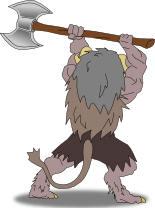 |
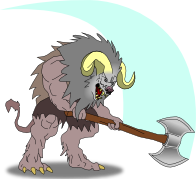
|
Hand to hand attacks use natural weapons or hand weapons such as clubs and blades. Add the attack modifier next to the weapon on the attacker's character sheet to hand to hand attack rolls. The target's best defense is the difficulty of a hand to hand attack.
- quick strike
- A quick strike is a quick hand to hand attack.
- strategic strike
- A strategic strike is a strenuous standing hand to hand attack which cannot be used while grappling and has a +5 attack modifier.
- cautious strike
- A cautious strike is a strenuous standing hand to hand attack which cannot be used while grappling and gives a +5 defense modifier until the character's next turn.
- powerful strike
- A powerful strike is a strenuous double power standing hand to hand attack. A couple of quick strikes has a better chance of hitting at least once, but a powerful strike does damage quickly and hurts larger and armored characters more easily.
Thrown Weapon Attacks
Add the throw modifier next to the weapon on the attacker's character sheet to thrown weapon attack rolls. The target's missile defense is the difficulty of a thrown weapon attack.
- quick throw
- A quick throw is a quick thrown weapon attack. The maximum range of this attack is the character's throwing ability modifier plus the difference between the character's strength and the weapon's heft. This action cannot be used with unwieldy weapons. Quick throwing is useful when speed or precision is important, such as knife and hatchet-throwing competitions or throwing sand in an opponent's face.
- powerful throw
- A powerful throw is a strenuous double power thrown weapon attack. The maximum range of this attack is twice the range of a quick throw. Unwieldy weapons cannot be thrown this way. Powerful throwing is useful when distance or damage is important, like throwing a javelin.
- heave
- Heave is a strenuous double power thrown weapon attack. Any object the character can lift can be thrown by heaving. Heaved objects are wildly imprecise, so the character has a -5 modifier to hit the target. The maximum distance the character can heave an object is the range of a quick throw.
Archery and Marksmanship Actions
Add the attack modifier next to the weapon on the attacker's character sheet to archery and marksmanship attack rolls. The target's missile defense is the difficulty of an archery or marksmanship attack.
- aim
- Aim is a quick gun or bow action which cannot be used while grappling. Aiming gives a +5 attack bonus to the character's next attack unless he takes damage or stun between aiming and the attack.
- quick shot
- A quick shot is a quick gun or bow attack.
- strategic shot
- A strategic shot is a strenuous gun or bow attack with a +5 attack bonus.
- cautious shot
- A cautious shot is a strenuous gun or bow attack with +5 defense until the character's next turn.
- draw and fire
- Draw and fire is a strenuous bow attack which does not require the bow to be already drawn.
- draw
- Drawing a bow is a quick action. A bow must be drawn before it can be aimed or fired. Drawing a bow requires the use of two hands. If the bow's heft is at least double the character's strength, the character cannot draw it at all. Bows tend to be lightweight, but the power of a bow comes from its spring instead of its mass. So the heft of a bow reflects the bow's pull and the strength required to draw the bow.
- unload
- Unloading a gun is a quick action. Most weapons are designed to be loaded quickly, but unloading them can be trickier. Unloading a weapon is usually a quick action. After unloading the character can hold onto the ammunition or lets it drop. Putting away the ammunition a character is holding requires an extra quick action. (If a character is holding several rounds of ammunition which must be put away sepearately, putting away each round is a quick action.)
- load
- Loading a gun is a quick action. Some weapons must be loaded before each attack, or reloaded after a certain number of uses. Replacing a clip of ammunition requires two quick actions: unload and load. If rounds of ammunition must be loaded individually, reloading requires an unload action and a load action for each round. For example, if a character has to load a revolver one bullet at a time then each bullet loaded is a quick action. Some weapons take several actions to reload. A "Brown Bess" musket can be fired about 3 times per minute with training, suggesting 9 actions to reload and 1 turn to fire. (Each of these actions required to reload the musket takes a full turn, so they are not quick actions.)
Grappling Actions
Grappling actions can give the character the dominant position. (See Action/Grappling.) Add the attacker's grapple attack to grappling attack rolls. Use the defender's grapple defense as the difficulty of grappling attacks.
- push
- A push, pull or shove is a quick grappling action which puts the target off balance. Successfully pushing, pulling and tripping up a standing opponent forces him to move in the direction the pushing character wants, and puts the pushed character off balance so he must make an roll against a difficulty of 8 using his grappling or acrobatics ability or fall down. If the pushing character is standing when his opponent falls down, the pushing character must choose whether to let go of him or follow him to the ground.
- trip
- A trip is a strenuous double power grappling attack which puts the target off balance. Successfully attacking a standing target's legs puts him off balance so he must make an roll against a difficulty of 8 using his grappling or acrobatic ability check or fall down.
- slam
- A slam is a strenuous grappling attack which puts the target on the ground. If the slamming character is standing and chooses to fall onto his opponent, then this attack has double power. The target will always end up on the ground, but he can still make an additional grappling or acrobatics ability roll against a difficulty of 8 to reduce damage from falling. If this roll is successful the damage is reduced by the attack's power, which means the slam will do no damage if the attacker does not fall onto the target and normal damage if the attacker does fall onto the target.
- hold
- A hold is a quick grappling action. Hold is not an attack, but this action allows a character to make a grappling success roll. If this roll is successful the character doing the hold can choose to take the dominant position or stop grappling with his opponent.
- wrench
- A wrench is a strenuous double power grappling attack. The damage and stun of a wrench are determined like the damage and stun of a blunt weapon.
- choke
- A choke is a strenuous double power grappling attack which only does stun. A choke always causes at least two stun if it is successful, regardless of armor and absorption.
- disarm
- Disarm is a strenuous double power grappling attack which forces an opponent to release his weapon or other possession. The difficulty of this action is the target's defense plus 5. If a character doing a disarm is successful and he has at least one free hand, he takes the weapon from his opponent. If he is successful but has no free hands, the opponent drops the weapon.
Other Actions
- drop
- Dropping to the ground is a quick action.
- stand
- Standing up is a quick action.
- instant stand
- Instant stand is a strenuous action which is like standing up normally except that the character using instant stand also gets a +5 defense modifier until his next turn.
- rest
- This action recovers all of a character's stun and gives him a +5 defense modifier until his next turn.
- cover
- A character can put himself at risk to protect a target, usually an ally. When the target is attacked, use the covering character's defense plus 5 instead of the target's defense. If the attack is successful it still hits the target. If the attack fails, it hits the covering character.
Health
- Stun and Resting
- Stun is the short-term effect of pain and injury. Characters can recover stun with the rest action. When characters are incapacitated they recover half of their stun (rounded up) each turn.
- Damage and Healing
- Damage is the long-term effect of injuries that heal slowly. Characters usually have a chance to recover damage once per week. This requires a success roll against the difficulty 10 plus 1 for every day the character exerted himself (by travelling or fighting for example) during that week, plus 1 for every time the character took damage or stun, and plus 5 for every time the character was incapacitated by damage. (There is no penalty for being incapacitated by a combination of stun and damage.) If the roll is successful, the character recovers half of his damage, rounded up. For example if the character has 5 damage and successfully heals, then he will recover 3 damage, leaving him with only 2 damage after healing.
- Sharpness
- Sharpness determines whether the attack power that gets through the target's armor becomes stun or damage. All the power of a sharp weapon becomes damage. Half the power (rounded down) of a blunt weapon becomes damage and the rest becomes stun. For example, 5 power getting through the target's armor absorption would become 2 damage and 3 stun to the target. All the power of a padded weapon becomes stun.
Armor
Any equipment with cover and absorption is armor. Normally, the best absorption of all the armor worn by a character is subtracted from the power of successful attacks against the character. However an attacker can aim any attack to avoid armor, which increases the difficulty of the attack by the cover of the armor avoided. The attack can avoid all or just some of the armor a character is wearing. An attack cannot avoid armor that has complete cover.
Consider for example a character wearing a leather jacket (5 cover, 2 absorption) and a crash helmet (2 cover, 5 absorption). If an opponent attacks the character without specifically avoiding the character's armor, the armor will absorb 5 power from each attack. If an opponent tries to hit the character where the armor provides no protection, the armor will absorb no damage, but the difficulty will be increased by 7 (5 cover from the jacket plus 2 cover from the helmet.) However, the opponent can also try to avoid only the helmet. Then the leather jacket absorbs 2 power from each attack but the difficulty of the attack is only increased by 2 (the helmet's cover.)
Sometimes armor is worn in layers. A brigandine (vest lined with metal plates) is often worn over a gambeson (padded coat) or chainmail. Bulletproof ballistic vests often have optional inserts which offer extra protection to vital areas such as the heart. If one piece of armor is completely overlapped by another, the overlapping area has the cover of the smaller piece of armor and the absorption of both pieces added together. (This is like subtracting the cover of the layer with the least cover from the cover of the layer with the most cover, and adding the absorption of the layer with the most cover to the absorption of the armor with the least cover.)
Attacking
- Charging Attack
- If a character travels more than 5 meters in a straight line before attacking, all in a single turn, the distance traveled (in meters) minus 5 is added to the power of the attack.
- Readying Weapons
- Unless surprised, characters will usually draw their weapons before the beginning of combat. If they have to ready the weapon during an action round, drawing the weapon from it's sheath, holster, scabbard, belt, or other convenient location is a quick action.
- Attacking from a Distance
- The difficulty of hitting a target depends on distance and the weapon's range. The difficulty of hitting the target increases by 1 for every 5% of the weapon's maximum range between the attacker and the target. 5% of the maximum range can be found by multiplying the maximum range by 0.05 or dividing the maximum range by 20. For example, if a weapon has 140 m range, then the difficulty of hitting targets with the weapon increases by 1 for every 7 m between the attacker and the target (140 / 20 = 7). The difficulty of hitting a target less than 7 m away would not be affected. The difficulty of hitting a target 7 to 13 m away would be increased by 1 (14 = 7 × 1), The difficulty of hitting a target 14 to 20 m away would be increased by 2 (14 = 7 × 2), The difficulty of hitting a target 70 to 76 m away would be increased by 10 (70 = 7 × 10), and so forth.
- Attacking in the Dark
- A lack of sufficient lighting can add to the difficulty of an attack if the attacker is not blind. Total darkness can increase the difficulty by +3 for a grappling attack, +4 for a striking attack and +5 for an attack from a distance. Very dim light rather than total darkness only increases the difficulty of grappling attacks by +1, striking attacks by +2 and attacks from a distance by +3.
- Random Damage (Optional Rule)
- Double power attacks only have double power if the attack roll is 13 or better before adding modifiers. If the attack roll is 12 or less before adding modifiers, the attack has normal power instead of double power.
- Critical Hit (Optional Rule)
- When an attack is automatically successful, increase the power of the attack by the weapon's power. In other words normal attacks have double power when they are automatically successful and double damage attacks have three times normal power when they are automatically successful.
Grappling
When grappling, regardless of weapon attack or defense, a character's grapple attack and grapple defense is used instead for grappling combat rolls. Striking while grappling uses the normal weapon attack and defense, with the appropriate grappling position modifiers.
A grappler can be in a dominant, neutral or inferior position relative to an opponent. Either one grappler's position is dominant and the other's is inferior, or they are both neutral. If a character is fully successful with any grappling action, he may choose whether to end up in a hold with the dominant position, or to release the hold. If a character fails, his opponent gets to decide whether to release the hold (but does not have a dominant position if that opponent did not already have it.)
Characters can grapple while standing (clinch fighting) or on the ground (ground fighting.) In a clinch, both grappling characters have a -5 modifier to all combat rolls except that a grappling character with a dominant position has a +0 modifier against his opponent in the inferior position. While ground fighting the grappling characters have the same modifiers except that instead of the -5 modifier they have a +5 defense vs. missile weapons and a -5 defense vs hand to hand attacks from other characters who are not grappling.
In order to for a pair (or other group) of grappling characters to move, one of the characters must successfully move the other using a grappling technique. Both characters then are moved unless both character's holds on each other are broken.
When a character falls down they he takes damage as if hit by a quick attack, except that the sharpness of the attack is based on the surface he lands on, and he takes at least two points of stun regardless of what armor he is wearing. If a character falls from a height the damage is increased by 1 for each meter he falls. If a character is pushed or thrown into a wall instead of the ground he takes damage as if falling.
Archery and Marksmanship
- Keeping a Bow Drawn
- The strength and concentration required to keep a bow drawn prevents a character from performing any other actions until the bow is fired. (A character can perform other actions while holding a crossbow, just like a loaded firearm.)
- Drawing a Crossbow
- Drawing a crossbow without a lever or crank is the same as drawing other bows. A lever or crank can decrease the heft required to draw a crossbow by increasing the number of turns required to reload. (See Equipment/Features/shots.)
Stance and Position
To simplify keeping track of success roll modifiers, there are only 10 different actions and positions to be aware of. A character can only be in one of these positions at a time. For example, a character cannot do a strategic attack while aiming or grappling.
- Standing
- This is the position where characters are ready to do most actions, but they are also fully exposed to missile weapon attacks such as thrown weapons, slings, bows and guns. While standing a character can move at normal speed and have no special modifiers from this position. When a character does the instant stand action, he has a defense bonus until his next turn.
- On the Ground
- While a character is crouching, crawling, sitting, or lying on the ground, they move more slowly (half movement, -5 to all striking attack rolls and defense against striking) but they are harder to hit with missile weapons (+5 defense against missile weapon attacks, even without cover, unless the attack comes from above.) Powerful, strategic and cautious attacks cannot be done from the ground.
- Aiming while Standing
- When a character aims a missile weapon they have a +5 to hit.
- Aiming on the Ground
- When a character aims from a sitting or prone position they have a +5 to hit plus the penalties for being on the ground: they move more slowly (half movement, -5 to defense against striking) but they are harder to hit with missile weapons (+5 to avoid a missile weapon, even without cover, unless the attack comes from above.)
- Clinch
- When a character is grappling and standing up, but does not have the dominant position, they have a -5 to all attack rolls and -5 defense against all attacks.
- Ground Fighting
- When a character is grappling on the ground, and does not have the dominant position, they have a +5 defense against missile weapon attacks, -5 to defense against other attacks, and -5 to all attack rolls.
- Dominant Position (Standing)
- When a character in a clinch (grappling while standing) has the dominant position, he has a +5 bonus to attack rolls and defense against the character in the inferior position, and -5 to all other combat rolls.
- Dominant Position (on the Ground)
- When a character has the dominant position while grappling on the ground, he has a +5 modifier to attack rolls and defense against the character in the inferior position, +5 against missile weapon attacks, and -5 to other attack rolls and defense against other attacks.
- Resting, Instant Stand and Special Attacks
- The rest action, cautious attacks and instant stand give a defense bonus until the end of the character's next turn, and strategic attacks have an attack bonus. Cautious attacks cannot be done on the ground. (See Action/Actions and Action/Attacking.)
| Standing | On the Ground | ||||
|---|---|---|---|---|---|
| Default | no modifiers | +5 defense vs. missiles -5 striking attack and defense | |||
| Aiming | +5 to hit | +5 to hit +5 defense vs. missiles -5 striking defense | |||
| Grappling | -5 to all rolls | -5 attack -5 hand to hand defense | |||
| Dominant | +5 vs. inferior -5 vs. others |
+5 vs. inferior -5 attack vs. others -5 hand to hand defense vs. others | |||
| Strategic | +5 to hit | n/a | |||
| Cautious | +5 defense | n/a | |||
| Resting | +5 defense | +5 defense |
Mounted Combat
- When the Animal Attacks
- When riding an animal, the animal will fight automatically if it is trained to do so. Every time the animal attacks or defends, the rider must make a roll using their riding ability to stay mounted. The difficulty of this roll is 10.
- Stopping the Attack
- To keep the animal from attacking the rider must make an animal handling success roll every time the animal is attacked, and every round that the animal's attacker is visible. The difficulty of this roll is 10 if the animal is unhurt, or 15 if the animal has stun or damage.
- Animals that do not Fight
- Animals trained to be ridden but not to fight will not attack if they are being ridden. Instead, they will try to run unless the rider makes a successful animal handling roll. This has a difficulty of 15 if the animal is unhurt, or 20 if the animal has stun or damage.
- Charging
- Instead of having the animal attack, a rider may use the animal's speed to do a charging attack. (See Action/Attacking.)
- Vehicles
- Vehicle combat is similar to mounted combat, but most vehicles will not fight or try to run from an enemy.
- Ramming
- When a driver rams a target, their driving ability modifier or the vehicle's agility - whichever is lower - is used as the attack modifier. A successful ramming attack results in an automatically successful ramming counterattack by the target against the part of the vehicle used to ram (usually the front.)
- Head-on and Broadside Collisions
- If the vehicle and target are moving in different directions (or if only the vehicle is moving) the extra charging damage caused by the speed of both the vehicle and the target is added to the damage taken by both.
- Rear-end and Sideswipe Collisions
- If the vehicle and target are moving in the same direction then the charging damage is based on the difference in the distances the vehicle and target moved in that direction since the beginning of their last turn.
Combat Example
To demonstrate the basic hand-to-hand combat system, Steven - the character from our character generation example - has a clone exactly like Steven, except the clone has not made itself a machete. Steven decides to take out the clone before it can get started on an machete of it's own. (See Character Creation/Character Generation Example.)
Steven, adult male human robber, 95 kg, 1.6 m height, 201 CP
1 speed, 0 agility, 3 strength, 7 toughness, 14 stamina, 5 running
2 unarmed combat, 4 one-handed weapons, 2 craftsmanship
2 hands (hand, 3 power, 2 attack, 12 defense)
2 feet (3 power, 2 attack, 12 defense)
1 machete (sharp, 0.5 kg, 3 heft, 5 power, 4 attack, 14 defense)
14 melee defense, 10 missile defense, 13 grapple defense, 3 grapple attack
0 best absorption, 0 total cover, ____ stun, ____ damage
The Clone, adult male human robber, 95 kg, 1.6 m height, 201 CP
1 speed, 0 agility, 3 strength, 7 toughness, 14 stamina, 5 running
2 unarmed combat, 4 one-handed weapons, 2 craftsmanship
2 hands (hand, 3 power, 2 attack, 12 defense)
2 feet (3 power, 2 attack, 12 defense)
14 melee defense, 10 missile defense, 13 grapple defense, 3 grapple attack
0 best absorption, 0 total cover, ____ stun, ____ damage
1. Establishing Initiative
Steven tries to ambush the clone. He uses stealth to sneak up on the clone, but Steven does not have the stealth ability so his success modifier is 0. Steven rolls a 13 and adds his modifier (0) to get a total of 13. The difficulty of this roll is 10 plus the clone's detection ability modifier, which is 0 because the clone does not have the detection ability. Steven's ambush is successful because Steven's total of 13 is greater than the difficulty of 10.
2. Combat Begins
Now on his first turn in the combat round, Steven is able to attack first and while the clone is not prepared to defend or counter attack, because of Steven's successful stealth roll.
Steven does a powerful strike with his machete. The attack modifier of this attack is Steven's attack modifier with the machete, which is 4. Steven's player rolls a 2, and adds Steven's attack modifier with the machete (4) so that his total attack roll is 6. The difficulty of the attack is the clone's defense. The clone's melee defense is 12. Steven's total of 6 is less than the clone's 12 defense, so Steven's attack misses.
3. The Clone's First Turn
Now the clone has initiative because his player is sitting next in order. 15 The clone launches a combo attack. The clone's speed is 1, but he has two hands and two feet. Because the clone has multiple weapons he can do an extra attack (as long as he doesn't use the same hand and foot for both attacks.) The clone's player decides that the clone's combo will be 2 quick strikes with his hands. Both of these quick attacks have an attack modifier of 2. The difficulty of the attack is Steven's melee defense which is 14.
- On the first attack in the combo, the clone rolls a 14, for a total of 16 after adding the clone's attack modifier (2). Because the clone's total (16) is greater than Steven's defense (14), the clone's first strike is successful. The power of this attack is 3. Because the clone's hands and feet are not sharp (or padded) half of the power, rounded down becomes damage (1) and the rest (2) becomes stun. Steven now has 2 stun and 1 damage.
- On the second attack in the combo, the clone rolls an 12, for a total of 14 after adding the clone's attack modifier (2). Because the Clone's total is only equal to Steven's defense, the attack misses.
4. The second round
When it is Steven's turn again, he decides to wait and counterattack.
Now it is the clone's turn, and the clone decides to do a powerful strike, but Steven gets to attack first because of his counterattack. Steven's response is a powerful attack of his own. Steven rolls a 14 for a total of 18 after adding his attack modifier (4). The clone's defense is 12. Because Steven's total (18) is higher than the clone's defense (12), his attack succeeds. This is a double power attack, so the attack power is 10. The clone has no armor with absorption to reduce the attack's power. Because Steven's machete is Sharp, the clone takes 10 damage and no stun.
The clone's stun plus damage (0 + 10 = 10) is now has more than his toughness (7) but less than his stamina (14). This means the clone is injured and can no longer do strenuous actions like the powerful strike he was planning. Instead, the clone chooses to evade, giving him a +5 defense modifier against all attacks until his next turn.
5. Steven's Third Turn
Steven decides to follow up his attack with a combo. He can only use the machete once in the combo because his speed is 1, but he can also use his other hand, legs, elbows, knees, head, etc. to do a second attack.
- Steven first attacks using a kick (a quick attack with one of his legs.) Steven's attack bonus with his head and legs is 2, and he rolls a 12, for a total of 14. The clone's defense is 12, but this is raised to 17 because the clone is evading. Steven's kick attack misses because Steven's total (14) is not greater than the clone's defense (17).
- For Steven's second attack he uses the machete, and he rolls a 17, for a total combat roll of 21. The clone's defense and evasion together is only 17, so Steven's attack is successful. The power of this attack is 5. Steven's weapon is sharp so the attack does 5 damage. The clone is now totally incapacitated because the clone's damage plus stun (0 + 15 = 15) is equal to or higher than the clone's stamina (14).
